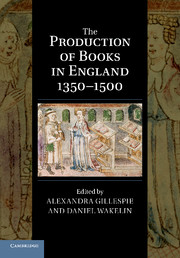Book contents
- Frontmatter
- Contents
- List of illustrations
- List of contributors
- Foreword
- Acknowledgements
- List of abbreviations
- Introduction
- 1 Materials
- 2 Writing the words
- 3 Mapping the words
- 4 Designing the page
- 5 Decorating and illustrating the page
- 6 Compiling the book
- 7 Bookbinding
- 8 Commercial organization and economic innovation
- 9 Vernacular literary manuscripts and their scribes
- 10 Book production outside commercial contexts
- 11 Censorship
- 12 Books beyond England
- 13 English books and the continent
- Afterword: the book in culture
- Bibliography
- Index of manuscripts
- General index
2 - Writing the words
Published online by Cambridge University Press: 05 May 2014
- Frontmatter
- Contents
- List of illustrations
- List of contributors
- Foreword
- Acknowledgements
- List of abbreviations
- Introduction
- 1 Materials
- 2 Writing the words
- 3 Mapping the words
- 4 Designing the page
- 5 Decorating and illustrating the page
- 6 Compiling the book
- 7 Bookbinding
- 8 Commercial organization and economic innovation
- 9 Vernacular literary manuscripts and their scribes
- 10 Book production outside commercial contexts
- 11 Censorship
- 12 Books beyond England
- 13 English books and the continent
- Afterword: the book in culture
- Bibliography
- Index of manuscripts
- General index
Summary
And for as moche as in the wrytyng of the same my penne is worn / myn hande wery and not stedfast myn eyen dimmed with ouermoche lokyng on the whit paper / and my corage not so prone and redy to laboure as hit hath ben […] I haue practysed and lerned at my grete charge and dispense to ordeyne this said book in prynte after the maner and forme as ye may here see / and is not wreton with penne and ynke as other bokes ben / to thende that euery man may haue them attones / ffor all the bookes of this storye named the recule of the historyes of troyes thus enpryntid as ye here see were begonne in oon day / and also fynyshid in oon day.
In the first book printed in English, The Recuyell of the Historyes of Troye in 1473 or 1474, William Caxton explains why he learned the craft of printing. This might not be the only or even the true explanation, but it reveals one thing which for contemporaries seemed to distinguish printing from ‘wrytyng’ (the Middle English word for scribal work). Writing requires an amount of time over which the scribe's hand can change in quality (be ‘not stedfast’), his eye can become less clear and his diligence or attention can become less ‘prone and redy’. Caxton's description of writing suggests that he felt not only that it took more time, but that it took time differently from printing.
- Type
- Chapter
- Information
- The Production of Books in England 1350–1500 , pp. 34 - 58Publisher: Cambridge University PressPrint publication year: 2011
- 5
- Cited by



